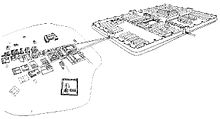Lauriacum
48°13′0″N 14°28′30″E / 48.21667°N 14.47500°E


Lauriacum was an important
History
Roman era
Where only a small Roman settlement was located at a ford over the Enns, the

In the late period, it became the base for a patrol boat fleet and the production site of a state shield factory. After the abandonment of the border in Noricum and Rhaetia as a result of the dissolution of the Western Roman Empire, Lauriacum once again played a historically important role in the evacuation of the Roman population by
Middle Ages
Although today part of the city of
Roman Lauriacum (Lorch) was mentioned in the Vita Sancti Severini and the Lauriacensis scutaria (fabrica). Notitia Dignitatum.[4]

Between 1960 and 1966 archaeological excavations were used to open walls of Roman predecessors (dated from 180 AD), also excavated was the first Christian church (4th–5th century) and other church buildings from the first millennium. The town's present church is Gothic and was built around 1300.
Archaeology
After completion of the excavation work in 1966 St. Laurenz quickly received new attention:
- 1968: new survey of the town parish church
- 1968: survey of the first titular archbishopric of Central Europe; First titular archbishop of Lauriacum was Girolamo Prigione, former nuncio in Guatemala, El Salvador and Mexico.
- 1970: Ascent to the Basilica minor by Pope Paul VI.
- 1988: Visit by Pope John Paul II, who conducted a Wort-Gottes-Feier ("Celebration of the word of God") liturgy at the Basilica of St. Lawrence with thousands of devotees in attendance.
Diocese of Lauriacum
Lauriacum is a
The ancient
Known bishops
- Maximilian of Celeia (flabout 284), the first bishop according to legend
- Constantius of Lauriacum (5th century), head of the municipality of Enns, mentioned the Vita Sancti Severini.
- Girolamo Prigione, apostolic nuncio, Apostolischer Pro-Nunctio, Apostolischer Delegat (1968–2016)
- Andrzej Józwowicz, apostolic nuncio, 2017–current
Lorcher fakes
The so-called
In the Basilica of St. Lawrence is an oversized painting (8 x 5 m) dating from 1728 which the corresponding bishops call and depict according to the Lorcher falsification.
See also
References
- ^ Lothar Eckhart: Die Stadtpfarrkirche und Friedhofskirche St. Laurentius von Enns-Lorch-Lauriacum in Oberösterreich. In: Forschungen in Lauriacum 11/1-3, Linz 1981
- ^ Roman Igl: Die Basilika St. Laurentius in Enns, OÖ. In: Beiträge zur Mittelalterarchäologie in Österreich 21, 2005, p141-152
- ^ Otto Winkler, St.Laurenz-Basilika zu Enns-Lorch. Kirchenführer, Hrsg.: Pfarramt St. Laurenz, Enns. Kunstverlag Hofstetter, Ried im Innkreis, 1990.
- ^ Lauriacensis scutaria (fabrica). Notitia Dignitatum occ. IX, 21.
- ^ Eintrag auf Giga-Catholic
